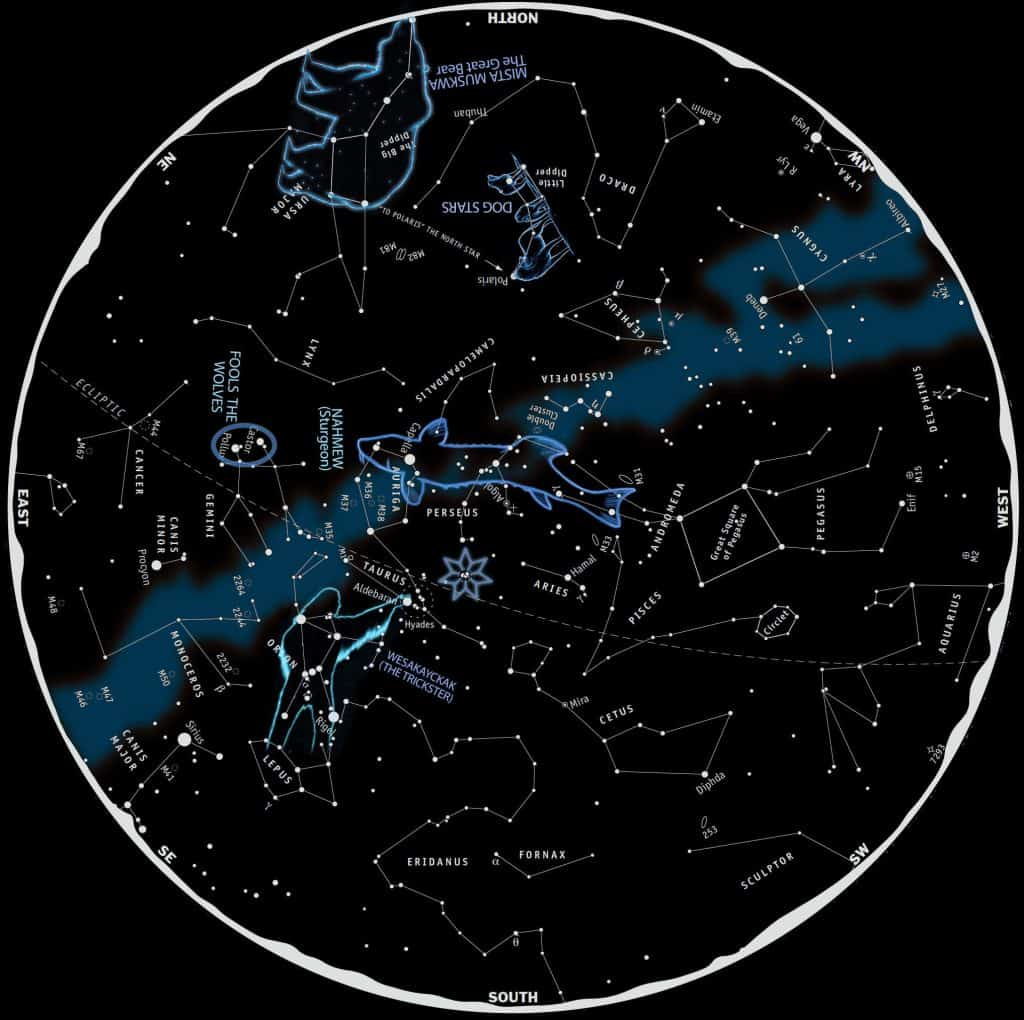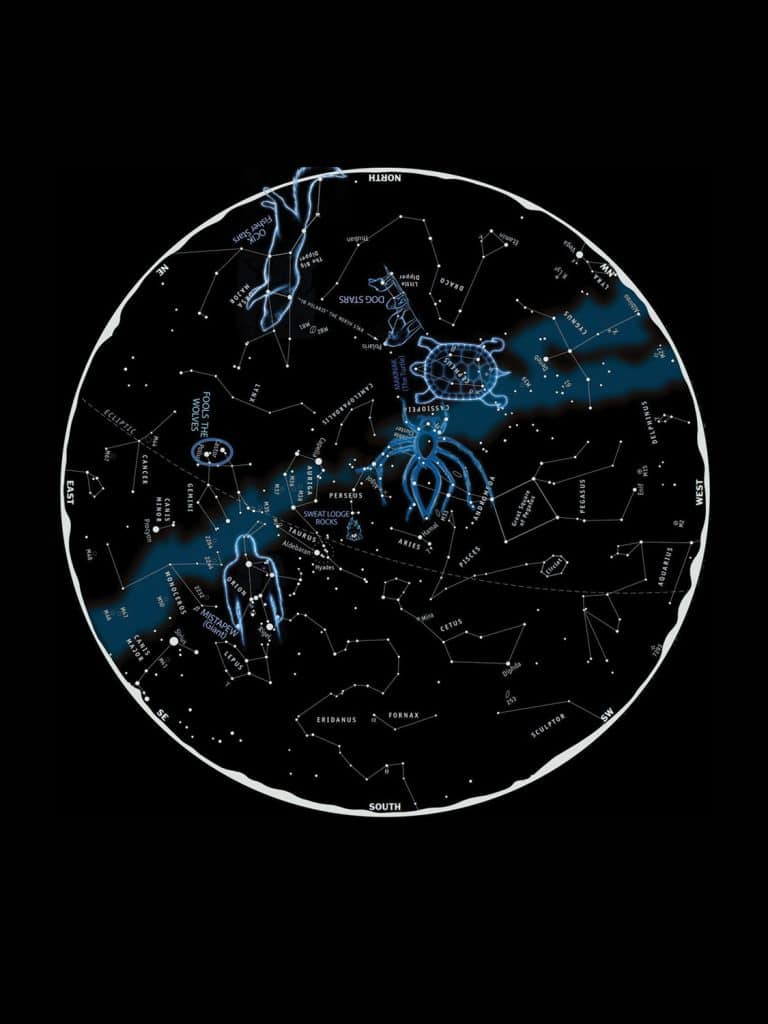by Wilfred Buck
All cultures on Nikawiy Aski (Mother Earth) have looked into the night sky with wonder and awe.
Each culture has its own perspective of the sky and its own particular understanding of how that awesome sky connects to its world views. Different cultures have always looked to the sky to make connections, seek order, and pursue an understanding of identity.
Prior to the Industrial Revolution, intimate knowledge of the sky was common. Star patterns and orbital paths were recognized. Lunar, solar, and planetary phases were identified and environmental occurrences within these patterns were noted. Pattern recognition was used as a directional indicator for travelling far and wide. By combining this recognition with prior knowledge, predictions could be made.
To have a better understanding of how Indigenous People see themselves connected to the sky, we must first understand what happened to those original belief systems. When Europeans first made contact with the fully functioning, established belief systems of Indigenous understandings—which were radically different from their own—the settlers determined that these “alien understandings” had to be subdued and discredited because they threatened their Christian ideology and base of power. Thus, the Indigenous worldview was subjugated, as was a self-sufficient way of life. Through the violence of colonization, whole worlds were destroyed, long-established thought processes eliminated, and genocidal practices began.
For Indigenous People, perspectives of the sky and our place among the stars have changed through the process of colonization, as have our world views and belief systems. As colonized peoples, Indigenous People took on the perspectives, world views, and beliefs of the colonizer. We were conditioned to see the world through a different lens. We were indoctrinated into believing in a totally different spiritual, religious, self-conscious, and intellectual understanding of who we thought we were. We were—and still are—brainwashed into thinking Indigenous People had no intellectual capacity, scientific methodology, self concepts, or depth of knowledge. We were told we were savages who needed to be “saved” and rescued from ourselves. It has only been in the last 20 years that Indigenous People have begun to look into the vast cosmos and wonder about their place in it… once again.
With the shroud of colonial propaganda slowly dissolving, Indigenous People are once again looking into their ancestors’ understanding of Misiwa (all that is [known and unknown]), and how humans fit into Paimatisiwin (life). We are in the process of healing our historical traumas.
We are beginning to connect with the depth of knowledge our ancestors held and through that understanding, we are beginning to realize our connection to Kisik Aski (the sky world). This worldview tells us everything is connected… the known and the unknown. This understanding tells us everything is energy. There is a term in Cree—Kisikookuk, which can be translated as “beings of light/energy/spirit.”
My People, the Ininiw (Cree), call the stars by the name “acakosuk”, derived from the root word “acak,” which can be translated into the term “spirit.” One basic understanding is that everything is made by Kitcimanito, the Great Spirit made of energy/light/spirit. Creator had a thought and that thought came into being. We assume the first thought was of energy and energy came into being. Thus everything has a spiritual base and we all emanate from one source… Kitcimanito.
For the Ininiw, Kitcikisik (the great sky), was an indicator of unfathomable immensity where only your Pawamiuk could offer glimpses of the infinite possibilities the sky represented. As Ininiw, we are told the connection we have with Kisik Aski is through Pawamiuk (dreams). Dreams tell us of our origins in the sky world and give us the foundation to our methodological steps for coming to knowledge. One of the main directional indicators in our Northern Hemisphere is Polaris, the North Star. My people call this important star Kiwatin. The root word for this term is Kiwi, meaning “home,” thus Polaris is recognized as “the going-home star.” Another designation it goes by is Ikakacit (“standing still”), since it is the only star in the Northern Hemisphere that does not move.
The thing people will come to see in regard to Indigenous astronomy is that Indigenous People have a number of names for any given topic of discussion. That is to say, there are multiple acimowinuk (“narratives/tellings”) to any particular thing, event, place, or instance.
An example of the depth of knowledge that connects us to Kisik Aski is the “telling” of Acakos Iskwiw (“Star Woman”). This narrative tells us we are Kisikookuk (“star beings … energy/light/spirit”). It also makes us aware of the concepts of particle theory, quantum theory, and thermodynamics. We are told that we are Kisikookuk and we travel through Misiwa. Our journeys take us in search of new experiences, sights, sounds, smells, textures, and feelings. We roam the cosmos as beings of light/energy/spirit. We transcend realities.
As the Acimowin goes… one particular being of energy we have come to know as Acakos Iskwiw was travelling the cosmos and came upon a spatial anomaly, which happened to be in what we now call the Milky Way galaxy. This phenomenon was a portal, a doorway from one reality to another… a wormhole.
Acakos Iskwiw happened to gaze through this portal and saw Nikawiy Aski. Acakos Iskwiw was intrigued and decided to go to this mysterious place. Acakos Iskwiw understood that to navigate the portal, assistance was needed and Acakos Iskwiw knew of the door-keeper, Okunowiskatopiw, who was in charge of this function. This particular Okunowiskatopiw was called Kokominakasis (“Grandmother Spider,” the net-maker).
Acakos Iskwiw approached Kokominakasis and asked for assistance to navigate the portal. Acakos Iskwiw was told there were three conditions that needed to be met if the portal was to be navigated.
- A physical form was to be used as a means of interacting with the physical world.
- A gift was to be taken through the doorway to act as a reminder of where Acakos Iskwiw originated.
- Acakos Iskwiw could not stay too long on the visit.
Acakos Iskwiw agreed to these conditions and Kokominakasis sent a single strand of webbing through the doorway and Acakos Iskwiw used the strand to climb down into this reality and reach Nikawiy Aski. When Acakos Iskwiw touched the Earth, she took a physical form… a human form. This is how we humans arrived on Earth. We are energy, then change form, and finally, return to energy when our visit in the physical world has ended.
The gift that was brought into this reality was Acakosahakoop (“the Star Blanket”), to remind us that we come from the sky world… from the stars.
As for not staying long on the visit… how long is long for a being of energy? Acakos Iskwiw stayed a lifetime, then returned to the cosmos.
So through Acakos Iskwiw, we all arrive here. We change form from energy to physical beings as we are lowered by a single strand of webbing we call the umbilical cord to Nikawiy Aski. We come for our visit, experience, teach, learn, feel, and age… then we leave.
Our elders always remind us that we are spirits learning how to be human… not humans learning how to be spiritual… then the cycle continues. Energy changes form… solid, liquid, gas, plasma.
We were given Acakosahakoop to remind us we come from Kitcikisik and that sacred blanket of stars is symbolic of a special place in the sky called Pakwon Kisik (“the Hole in the Sky”—widely known as the Pleiades). The original blanket had Tipahkop Acakosuk (“seven stars”) on it to symbolize the stars of the Pleiades. As more and more humans arrived here to visit, there was a decision made to honour the first one here, Acakos Iskwiw, so an extra point was added to the seven-pointed star blanket to remember the Kokominow (“first grandmother”), Acakos Iskwiw. Therefore, today we have an eight-pointed star blanket.
On a side note: Kokominakasis is the being who gifted humans the Dreamcatcher, which filters energy that transcends realities. We also understand that there is a connection from our dreams to Pakwon Kisik, which gives us glimpses of infinite possibilities, like the ones explored in quantum theory. We constantly dream when we sleep, no matter if we remember those dreams or not. We dream… we make connections, get inspiration, direction, guidance, healing, understanding, and broaden our possibilities.
This is one of the sacred tellings from the perspective of the Ininiw but this telling is told across Mikinak Ministik (“Turtle Island”) because Indigenous Nations understand that we are part of a greater whole that originates in Kitcikisik.
We come from the stars and understand that misiwa is energy/light/spirit.
Ninanaskomitinan (I am humbly grateful)
- Pawami Nikititicikiw (the Dream Keeper) a.k.a. Wilfred Buck
Note: To listen to Wilfred Buck share Cree Star knowledge, please visit the Pinnguaq website to visit an interactive environment filled with a selection of constellations.
| Cree Word | Pronunciation | English Meaning |
| Nikawiy Aski nikâwiy askiy ᓂᑳᐏᐩ ᐊᐢᑭᐩ *Also known as okâwîmâw askiy ᐅᑳᐑᒫᐤ ᐊᐢᑭᐩ) | neck-away- as-kee | Mother Earth |
| Misiwa misiwê ᒥᓯᐍ | mees-wa | All that is (known and unknown) |
| Paimâtisiwin pimâtisiwin ᐱᒫᑎᓯᐏᐣ | pay-mah-tis-e-win | Life |
| Kisik Aski kîsik askiy ᑮᓯᐠ ᐊᐢᑭᐩ | key-sick-as-kee | The sky world |
| Kisikookuk kîsîkôkak ᑮᓰᑰᑲᐠ | kee-see-coo-cuck | Beings of light/energy/spirit |
| Ininiw ininiw ᐃᓂᓂᐤ | in-in-niw | Cree (“the four-bodied” or “of the four” |
| Niwo niwo ᓂᐓ | nee-you | four |
| Acakosuk (Plural) acâkosak ᐊᒑᑯᓴᐠ Acakos (Singular) acâkos ᐊᒑᑯᐢ | ah-cha-kos-uk ah-cha-kos | Stars Star |
| Acak ahcahk ᐊᐦᒐᕽ | ah-chak | Spirit |
| Kitcimanito kihci-manitow ᑭᐦᒋ ᒪᓂᑐᐤ | kit-chi-man-it-oo | The Great Spirit made of energy/light/spirit |
| Kitcikisik kihci-kîsik ᑭᐦᒋ ᑮᓯᐠ | kit-chee-kee-sick | The great sky |
| Pawamiuk pawâtamowina ᐸᐚᑕᒧᐏᓇ | pah-wah-mi-uk | Dreams |
| kiwatin kîwêtin | kee-way-tin | The North Star |
| kîwî ᑮᐍᑎᐣ ᑮᐑ | gii-wai | Home |
| Ikakacit îkâ kâ-âhcît ᐄᑳ ᑳ ᐋᐦᒌᐟ | eh-kah-kah-chet | Standing Still *Also known as the North Star |
| Acimowinuk (plural) âcimowinak ᐋᒋᒧᐏᓇᐠ *Also known as âcimowina Acimowin (singular) âcimowin ᐋᒋᒧᐏᐣ | ah-chim-oh-win-uk Ah-chim-oh-win | Narratives/tellings Narrative |
| Acakos iskwiw acâhkos iskwîw ᐊᒑᐦᑯᐢ ᐃᐢᑹᐤ | ah-cha-koos-is-kew-wew | Star Woman |
| Okunowiskatopiw okanawsikâtapiw ᐅᑲᓇᐤᓯᑳᑕᐱᐤ | oh-cun-now-wisk-ahtwo-pew | Doorkeeper in charge of… |
| Kokominakasis kohkominahkîsîs ᑯᐦᑯᒥᓇᐦᑮᓰᐢ | ko-ko-min-ah-kah-sees | “Grandmother Spider,” the net-maker |
| Acakosahakoop acâhkosakohp ᐊᒑᐦᑯᓴᑯᐦᑊ | ah-cha-coos-ah-ha-coop | Star blanket |
| Tipahko acakosak tîpakohp acâhkosak ᑏᐸᑯᐦᑊ ᐊᒑᐦᑯᓴᐠ | teh-pah-coop ah-cha-koo-suk | Seven Stars |
| Kokominow kohkominaw ᑯᐦᑯᒥᓇᐤ | coo-coo-min-ow | First Grandmother |
| Pakwon kisik pakonî kîsik ᐸᑯᓃ ᑮᓯᐠ | pah-gwun-gii-sg | Hole-in-the-sky – better known as the Pleiades |
| Mikinak Ministik mihkinâhk ministik ᒥᐦᑭᓈᕽ ᒥᓂᐢᑎᐠ | mick-in-ack minonis-tick | Turtle Island |
| Ninanaskomitinan ninanâskomitinân ᓂᓇᓈᐢᑯᒥᑎᓈᐣ *Also known as ninanâskomon ᓂᓇᓈᐢᑯᒧᐣ | ni-nah-nask-oh-mit-tin-nan | I am humbly grateful |
| Pawami Nikititicikiw pawâmi nikititicikiw ᐸᐚᒥ ᓂᑭᑎᑎᒋᑭᐤ | pah-wah-mi Nih-kih-tee-tee-chi-ghew | The Dream Keeper |
[buzzsprout episode=’10573645′ player=’true’]



